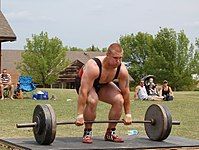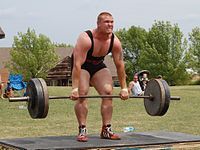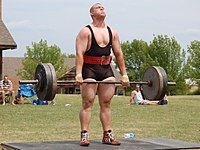User:Forgirl023/sandbox
This article needs additional citations for verification. (June 2009) |
The deadlift is a weight training exercise in which a loaded barbell is lifted off the ground to the hips, then lowered back to the ground.[1] It is one of the three canonical powerlifting exercises, along with the squat and bench press.
Overview
[edit]Deadlift refers to the lifting of dead (without momentum) weight, such as weights lying on the ground. It is one of the few standard weight training exercises in which all repetitions begin with dead weight. There are two positions you can approach when doing the deadlift, which include the conventional deadlift and sumo-deadlift. In most other lifts there is an eccentric (lowering of the weight) phase followed by the concentric (lifting of the weight) phase. During these exercises, a small amount of energy is stored in the stretched muscles and tendons in the eccentric phase, if the lifter is not flexible beyond the range of motion.
World records
[edit]- The record for a raw deadlift (a deadlift performed without the aid of a deadlift suit, where only a weight belt is allowed) is 1015 lbs by Benedikt Magnusson. This lift currently exceeds the equipped record. [2][3]
- The record for an equipped deadlift (a deadlift performed using a deadlift suit using a standard bar and plates where straps are disallowed) is 457.5 kg (1,009 lb) by Andy Bolton.[4]
- The world record deadlift in strongman competitions (using a standard bar and plates but straps and hitching allowed) is 445 kg (981 lb) by Benni Magnusson set at 2014's Giants Live competition in Melbourne, Australia. [5]
- The world record in strongman competitions (partial deadlift with wrist straps from 18" off the floor with high bending bar) is 535 kg (1180 pounds) by Tom Magee in the 1983 World's Strongest Man competition.
- The record for the tire deadlift (a deadlift performed using hummertires instead of weightplates) is 524 kg (1155 lbs) by Žydrūnas Savickas. [6] [7]
- The record for the single handed deadlift is 330.0 kg (727.5 lb) by Hermann Görner in Leipzig 1920.[8]
Muscles involved
[edit]The deadlift is a compound movement that works a variety of muscles groups:
- The grip strength (finger flexors) and the lower back (erector spinae) work isometrically to keep the bar held in the hands and to keep the spine from rounding.
- The gluteus maximus and hamstrings work to extend the hip joint.
- The quadriceps work to extend the knee joint.
- The adductor magnus works to stabilize the legs.
The deadlift activates a large number of individual muscles:
Gears
[edit]To avoid accidents from happening while performing deadlifts, prepare yourself with proper gears are recommended. Some example of lifting gears would be
- Knee wraps - Knee wraps are designed to absorb stresses from your knees. The are long and heavy which can stretch out to about twenty feet long.
- Wrists warps - Wrist wraps are not only for deadlifts, they can be also be used for bench press, and any other heavy lifting exercise that require wrist supports.
- Belts - The benefits from power lifting belts are beyond people's expectation, it "increases intra-abdominal pressure, which stabilizes your entire midsection,"[9] especially when you are performing a heavy movement like squat and deadlift, which requires a lot of stability and core strength.
- But basic training gears would be acceptable for beginners as well, for example, training/running shoes , t-shirt, and shorts.
Variations
[edit]Setup
[edit]Different variation of deadlift require different setup, but essentially are,
- Feet Posision - A proper feet placement is very important for deadlifting. Make sure you always want your shins to be as close as possible to the bar. This allows you to lift the bar up without shifting your core toward to the bar. It can also ensure the weight from swing back and hit your shin or forward and put more pressure on your spine. [10]
- Stance Width - Except for sumo deadlift, place your feet slightly wider than shoulder width. Feet should be parallel to each other or slightly pointing to the sides. If you are a beginner and you don't know how to place your feet, try to jump vertically a couple of times. The landing position of the feet will be your deadlift stance. [11]
- Bar Grip Width - Place your arms completely straight and perpendicular to the floor. Tighten your shoulders and arms, make sure your arms are in a position as close as your body possible. Narrower grip than shoulder width will force your shoulder blades to come forward and injury might occur. [12]
Form
[edit]- Conventional deadlift (Standard deadlift): Conventional deadlift, also called standard deadlift, is a type of deadlift which performed with your feet approximately shoulder width with a static bar as the starting position. Standard deadlifts embodied all kinds of deadlift, thus it includes all the foundation movement of deadlifts.
- First, place your arms on the bar as the techniques we have discussed,
- Second, sit back NOT sit down; when you sit back, you allow yourself to maintain the center of gravity at the proper point and also maintain the tightness of your body, which both would make the lift much easier. [13] Lift the bar as your want to push your feet through the floor, let your legs do most of the motions in the lower range.
- After the bar leaves the floor, bring your chest up and hips forward at the SAME time. You want to do them simultaneously because by doing one without the other would stimulate only one part of your body to lift the bar, which will put a lot of pressures on them. [14]
- Finally, to lockout means by having a full extension of your knees and hips and pulling your shoulders tight. ATTENTION, be sure not to exaggerate the movement by pulling your back too hard because this will cause to arch your lower back.[15]
- Romanian deadlift: Unlike a standard deadlift, which begins from the floor with a concentric movement, this variation begins from the top. For this reason it is not technically a deadlift. Jim Schmitz claimed to name this exercise in 1990 after the nationality of Nicu Vlad who first performed it.[16]
- Starting with an eccentric phase and incorporating a stretch reflex, it eliminates most of the quadriceps contribution, putting more emphasis on the hamstrings and glutes. It is performed by standing with barbell held in front of the body with knees unlocked and bending at the hip while keeping the back straight, then extending the hip to lockout and hyperextending the lower back for maximum contraction.[17]
- Sumo deadlift is a variation of the deadlift whereby the legs are spread far apart to the sides (arms reaching down inside of legs), mimicking a sumo stance, hence the name. This variation changes the emphasis of the lift to the legs instead of the back. The sumo deadlift is purported to be easier for those with large waists as well as those with relatively long torsos and shorter arms, and is mainly used by powerlifters to increase the amount of weight lifted, rather than as a training tool.
Weights
[edit]Deadlifts can be performed using dumbbells, barbells, or kettlebells with one hand or two hands & with one leg or two legs. Variations are only limited by the athlete's imagination. Other variations are the side deadlift or suitcase deadlift, rack pulls, deadlift lockouts, deficit deadlift or deadlift from a box (pulling from the floor while standing on a built or improvised low platform).
Each of these variations is called for to address specific weaknesses in a lifter's overall deadlift. For instance if the athlete has difficulty breaking contact at max. weight, deficit deadlifts are performed to strengthen the gluteus maximus and hamstrings due to the greater range of motion required by standing on the low platform or low box. On the other hand if the lifter has no problem with breaking contact with the floor but has difficulty locking out, he should perform rack pulls to strengthen his upper back, posterior deltoids, and trapezius muscles while de-emphasizing the gluteus and hamstrings.
The archaic "dead weight lift", or "dead weight lift with lifting bar" involved a T-bar with weight loaded on it while the lifter stood on sturdy chairs or other such platforms.[citation needed] A remarkably heavy amount of weight could be lifted in this manner due to its short range of motion; the main limitations are in the grip. This lift is similar to the modern day rack pulls, where a heavy amount of weight is lifted deadlift style a short distance in a power cage or squat rack.
Grips
[edit]Typically, there are two grips used: overhand (pronated) or a mixed overhand-underhand (supinated) (sometimes called "offset," "staggered," "alternating", or "mixed") grip. Depending on forearm strength, the overhand grip may result in the bar potentially rolling about. Some argue the mixed grip is capable of neutralizing this through the "physics of reverse torsion." The mixed grip also allows more weight to be used for this reason.
In order to prevent the bar from rolling out of the hands, some lifters have been known to use an Olympic weightlifting technique known as the hook grip. This is similar to an overhand grip, but the thumbs are inside, allowing the lifter to "hook" onto them with the fingers. The hook grip can make it easier to hold heavier weights using less grip strength, and keeps both shoulders and elbows in a symmetrical position. While it theoretically takes much of the stress off of the joints which might be created by the twisting of a mixed grip it has the disadvantage of being extremely uncomfortable for the thumbs, something which those who advocate it says will pass once a lifter becomes accustomed to it. Another, but rarely used method is a combination of the mixed overhand-underhand grip and the hook grip, preferred by people who lift heavier weights than their grip can handle, but who don't want to rely on lifting straps or other supportive gear.
Many powerlifters adopt the overhand grip for their lower weight sets and move to the mixed grip to lift larger weights so they can achieve their one rep max.
Alternations
[edit]Instead of using the bar, which require performers to load up weight, there are other alternatives which mimicked barbell deadlift.
- Dubbell or Kettlebell Deadlift
- Trapbar deadlift - is a variation of the deadlift using a special U-shaped bar (a trapbar). This allows more clearance for the knees to pass "through" the bar. To perform the trapbar deadlift, one loads the bar, steps inside the hollow portion of the bar, bends down, grasps the handles, stands erect, then lowers the bar to the ground in the exact opposite path. Proponents of trapbar deadlifts include Hardgainer Magazine, Bob Whelan, the Cyberpump website, and Dr Ken Leistner and iron-game writer Paul Kelso.
Benefits
[edit]Proper deadlifts training can result in various area
- Improve absolute strength, speed strength, rate of force development, flexibility, and core stability
- Improve soft tissue and bone strength
- Reduce the likelihood of various injuries during sport and activities of daily living
Common mistakes
[edit]- 1. Wrong hips movement - Many lifters, even intermediate lifters, make the same mistakes on using their hips during the movement. The right hips movement should be "hips forward and back" but not "hips up and down". As we have discussed in the conventional deadlift techniques above, we should push our hips toward to lift the bar up (while also using your quads). But to initiate the lowering phase of the movement, you should also cooperate your hips movement, pushing your hips backward to bring down the bar instead of bending your back (spine) to do so. [18]
- 2. Not pushing through the heels - By pushing through the heels, you can engage your gluteus and hamstrings more efficiently. [19]
- 3. Standing too far away from the bar - The further you stand away from the bar, the more work your body has to do. You can visualize from carrying grocery bags, the closer you place the bags to your body the easier to lift them up. [20]
- 4. Back Lockout - To complete a proper lockout, you should lock it with your gluteus, by squeezing them together a complete hip extension can be completed. People mistaken the proper lockout by extending their back to fully extend their body, but that might result in hyperextend backward and tweak their lower back. [21]
- 5. Rushing to the top - When extending too fast to the top, lower back has to extend from neutral to rounded position. And the result would be bizarre. [22]
References
[edit]- ^ "The Free Dictionary: Deadlift". Retrieved 15 February 2014.
- ^ http://www.youtube.com/watch?v=5M13EBl_jF0
- ^ http://www.lift.net/2013/01/28/benedikt-magnussons-training-leading-up-to-his-1015-deadlift-world-record/
- ^ Soong, Michael: "Men's Superheavyweight Weight Class Top 20", "Powerlifting Watch", Retrieved: 2009-06-20
- ^ "Strongman Deadlift World Record". Retrieved March 8, 2014.
- ^ http://www.lift.net/2014/03/01/zydrunas-savickas-1155-lb-tire-deadlift-world-record/
- ^ http://www.youtube.com/watch?v=uNDxzSWbto8
- ^ "Single Handed Deadlift World Record". Retrieved May 22, 2012.
- ^ http://articles.elitefts.com/training-articles/benefits-and-proper-use-of-weightlifting-belts/
- ^ http://www.builtlean.com/2013/03/27/proper-deadlift-form/
- ^ http://powerliftingacademy.com/the-deadlift-exercise-guide/
- ^ http://powerliftingacademy.com/the-deadlift-exercise-guide/
- ^ http://www.builtlean.com/2013/03/27/proper-deadlift-form/
- ^ simultaneously
- ^ http://www.builtlean.com/2013/03/27/proper-deadlift-form/
- ^ IronMind article: Jim Schmitz on the Lifts: Romanian DeadLift: "the “discovery” of the RDL was in my gym, The Sports Palace, in San Francisco in 1990 .. Nicu Vlad, of Romania .. proceeded to do this lift, a combination stiff-leg deadlift and regular deadlift, but actually neither. Someone watching asked what the exercise was he was doing. Nicu just shrugged his shoulders and said it was to make his back strong for the clean. Dragomir also said the same; it was just a lift that Nicu had developed for his back and clean. .. Someone taking notes asked what this lift was called. .. Nicu and Dragomir didn’t have a name, so I said, “Let’s call it the Romanian deadlift or RDL for short,” and every one agreed"
- ^ "Romanian Deadlift", Core Performance", Retrieved on 2009-06-20
- ^ http://blogs.menshealth.com/fitness-pros/the-5-most-common-deadlift-technique-mistakes/2011/04/18/
- ^ http://blogs.menshealth.com/fitness-pros/the-5-most-common-deadlift-technique-mistakes/2011/04/18/
- ^ http://blogs.menshealth.com/fitness-pros/the-5-most-common-deadlift-technique-mistakes/2011/04/18/
- ^ http://blogs.menshealth.com/fitness-pros/the-5-most-common-deadlift-technique-mistakes/2011/04/18/
- ^ http://blogs.menshealth.com/fitness-pros/the-5-most-common-deadlift-technique-mistakes/2011/04/18/
Further reading
[edit]- Mark Rippetoe with Lon Kilgore, Starting Strength, The Aasgaard Company Publishers, 2005, ISBN 0-9768054-0-5
- Frédéric Delavier, Strength Training Anatomy, Human Kinetics, 2001, ISBN 0-7360-4185-0
External links
[edit]This page or section may contain link spam masquerading as content. (April 2013) |
- How to Deadlift like a Pro: In-depth look at Deadlift Form
- Deadlift Technique Reference Photos
- A step-by-step guide to Deadlifting
- Benedikt Magnusson breaking the record under WPO powerlifting rules
- Deadlift animation
- Romanian Deadlift - Core Performance
- Database & Rankings of Best French Deadlifters - Club150
- Video Demonstration of Proper Deadlift Technique
- Proper Way To Deadlift




